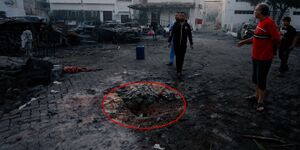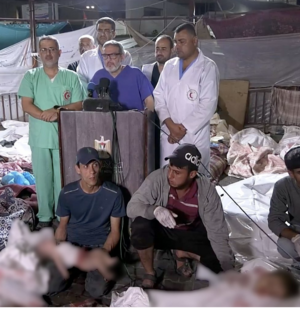Marie Naja (talk | contribs) No edit summary |
Marie Naja (talk | contribs) No edit summary |
||
| Line 1: | Line 1: | ||
<div class="metadata"> | <div class="metadata"> | ||
==The Scenography of War== | |||
'''Marie Naja Lauritzen Dias''' | |||
</div> | |||
Since Jean Baudrillard’s provoking claim that "the Gulf War did not take place" (1991) warfare has been associated with illusion. Today’s hyper-medialized warfare raises new questions about conflicts of reception and 'truth value' in the images we see. | Since Jean Baudrillard’s provoking claim that "the Gulf War did not take place" (1991) warfare has been associated with illusion. Today’s hyper-medialized warfare raises new questions about conflicts of reception and 'truth value' in the images we see. | ||
Revision as of 14:23, 31 January 2024
Since Jean Baudrillard’s provoking claim that "the Gulf War did not take place" (1991) warfare has been associated with illusion. Today’s hyper-medialized warfare raises new questions about conflicts of reception and 'truth value' in the images we see.
We're accustomed to seeing distant wars through fragmented snapshots, often captured amid the disorder of conflict via news media or blurry poor images shared via camera phones (Steyerl 2013). Such alleged spontaneous representations reproduce an experience of a certain 'authenticity' of the image. Blurriness and pixelation have become technical testimonies of the truth value of images of war. “Pixelating – or blurring has taken over the role of authenticity”, as the Artist Thomas Hirschhorn has phrased it in relation to his Pixel-Collage series. This stands in sharp contrast to the staged image, that this article centers around: a still-photo from a live-broadcasted press conference held in the rubbles of the bombed al-Ahli Baptist hospital in Gaza on oct. 17, 2023. An image that seemed to echo Hito Steyerl's question in "Documentary uncertainty": "Is this really true?" (Steyerl, 2009).
The disturbing thing about this image, that quickly circulated on social media and on news sites, is less to be found in its extreme gruesomeness, epitomized in the dead baby in the arms of the man sitting at the center of the image. It is rather the almost collage-like scenography, the clash between the formal press conference and the warzone. Somewhat imitating Martha Rosler’s collage-technique in her photomontage-series "House Beautiful" (1967-72), this clash of contradictory forms creates a Brecht-like alienation towards the war. The very thought of practically preparing and arranging the podium, the stage, and the dead bodies is absurd: Did the speakers straddle over the dead bodies to the stage? Did someone yell "action" before livestreaming this macabre scene? The predictability in the composition of the official press conference, following a pre-set choreography of elements, is disrupted by the dead bodies covered by blood-stained sheets, placed in a circle around the podium. Like the other elements of the press conference – spotlights, stage, microphones – the bodies have been staged in the frame of the camera directed at the scene. If one thing, the video, the still-images that quickly circulated, hereby brought testimony to the very "exhibition value" of war (Benjamin 2008). This "exhibition value" of the war site was only bolstered in the subsequent days and weeks where forensic image analyses of the crater and the surrounding areas frantically began to circulate on X and on global media. The still-photo was different though. It's composition was meant to be seen, it was staged, or it became staged, and thus opposed and affirmed in one and the same gesture our very desire for authentic images of war. Thus rephrasing Steyerl's initial question: "Are images (of war) ever 'really true' or un-staged?"


